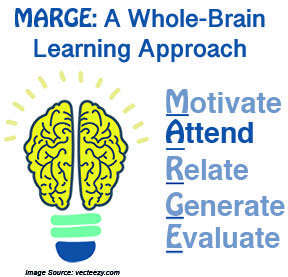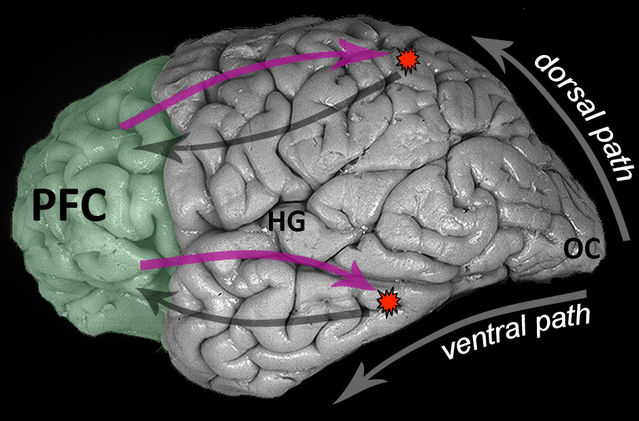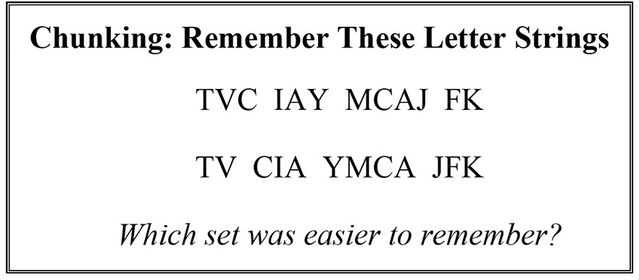Attention
Lifelong Learning and Active Brains: A Is for Attend
Efficient Learning Requires Focused Attention
Posted August 13, 2018

We spend our waking moments bombarded by a cacophony of sensory signals—sights, sounds, smells, tastes, touches—so much so that it is amazing that we can make any sense of the world around us. Add internal gyrations—feelings and random thoughts—and it becomes evident that our brains require some way of focusing and guiding mental activities. Information overload is a major obstacle toward efficient learning, and thus our ability to attend to specific thoughts and sensory inputs is essential. It is the second principle of MARGE, our whole-brain approach to learning.
Try this little demonstration—attend to your breathing for a few seconds and make yourself consciously aware of the air moving in and out of your lungs. Now switch your focus and attend to the pressure on your bottom as you sit. Clearly, we have the capability of selecting, maintaining, and switching between mental events (you can now stop thinking about your bottom and focus on the topic at hand). It is your prefrontal cortex (PFC), the front 28% of your cerebral cortex, that enables you to control mental activity. Consider your brain as a large orchestra with musicians located in various cortical "sections." The PFC acts as your conductor, modulating activity by increasing it in some regions and suppressing it in others. Without a conductor to control volume, timing, and rhythm, the orchestra's performance would likely appear haphazard and disharmonious.

The figure above shows how the PFC interacts with the rest of the brain. The occipital cortex (OC), located at the very back of the brain, is where visual signals first enter the cerebral cortex. From there, visual information is processed along two primary paths—a dorsal ("where") path devoted to spatial processing, and a ventral ("what") path devoted to object processing. Auditory signals emanate from Heschl's gyrus (HG) with surrounding regions devoted to processing speech, natural sounds, and music. Distributed throughout the cortex are large multisensory regions involved in linking or integrating sensory signals. At every stage of processing, there are fibers sending signals directly to the PFC as well as feedback projections from the PFC to the same posterior regions (purple arrows in figure). These feedback projections enable the PFC a means of modulating (increasing, decreasing, maintaining) activity in other cortical regions, a mechanism psychologists call executive control.
From this brain perspective, it is clear that the PFC never acts in isolation just as a conductor is nothing without the orchestra. The PFC works by way of selecting, maintaining, and guiding activity in many other cortical regions. Yet it is easy to appreciate how important the PFC is in conceptual learning. If our thoughts are scattered and we are not paying attention to the topic at hand, then our ability to register and remember new information will falter miserably. For efficient learning, we need to focus on relevant information and guide our thoughts toward the integration of new information with existing knowledge. As such, the PFC is essential for top-down processing—as it is responsible for determining what mental features are active at any given moment. In the past, we used the term short-term memory to refer to active mental states, but there was confusion over what "short-term" means (seconds?, minutes?). Psychologists now use the term working memory to describe the specific mental features that are active (i.e., working) at any given moment.
The nemesis of efficient learning is mind-wandering. We are all prone to stray thoughts and daydreaming. Moreover, in the classroom the temptation of texting, social media, and web surfing makes it that much more difficult to attend to the lecturer. Classroom studies have shown that mind wandering is rampant with only 40-46% of students paying attention to the lecturer at any given moment. There is one critical time for capturing attention, which is the settling-in period—the first four or five minutes of a lecture. In one study, chemistry students were instructed to indicate with a clicker each moment during a 50-min lecture when they had been mentally distracted (mind wandering, texting). A consistent lapse in attention occurred during the settling-in period, as if the lecturer was unable to grab the students' attention at the beginning. Thereafter, attention waxed and waned with the frequency of lapses increasing near the end of the lecture. Students were most attentive during class demonstrations, which reinforces the need to break up a lecture with such engaging methods. Indeed, when you begin a learning session—for yourself or as an instructor—it is critical to grab attention during the settling-in period by considering the big picture, asking goal-oriented questions, or introducing some real-world example or demonstration.
How can we sustain attention while learning? Top-down engagement is the key. We need to guide our thoughts and focus on relevant bits of information that add to our knowledge base. An important way to sustain attention is to chunk information—that is, group new information into meaningful units. Try to remember the two sets of letter strings in the box below:

Even though the two letter strings are identical, it is much easier to remember the second set as it is grouped (i.e. chunked) into four meaningful units rather than 12 seemingly random letters. We already have existing knowledge of TVs and the CIA—as they are meaningful units to us. Whenever we are learning—such as seeking information on Wikipedia or watching a YouTube video—we must focus on how new information is meaningful to us. Group information into larger units of knowledge. Maintain focused attention by asking yourself, how does this new information fit in to what I already know?
To focus attention and facilitate chunking, I suggest doing three things while learning—categorize, compare, and contrast. You can consider these commands as the three C's of sustaining attention and top-down engagement. That is, while learning new material, say a new term or fact, bring to mind related information that will help you categorize (i.e., catalog) the new information into your existing knowledge base. Learning is facilitated by finding similarities (comparing) and differences (contrasting) between new material and what you already know. While reading this blog, you might ask, How does chunking relate to top-down processing? How is the settling-in period contrasted with other times when attention lapses occur? When you actively work on the 3 C's, you automatically begin to pay attention to relevant features of new material and how they can be integrated into your existing schema.
Keep in mind the benefits of guiding your learning experience. One way to do this is to view learning as creating for yourself a guided tour toward new conceptual knowledge. Consider those short nature walks that guide you with an assortment of placards describing plants and scenic viewpoints along the way or a guided tour through an art or science exhibit that informs you about a period of art history or geological time. As you walk through such informational paths, you experience new facts and concepts with a specific learning goal in mind—such as learning about a local ecosystem, art period, or scientific phenomenon. At home, whenever you confront new material, consider the "path" that you're taking toward new knowledge. Be aware of how the facts picked up along the way are linked and work together to provide a framework toward understanding the topic at hand. With respect to this blog, you might ask: What aspects of attention are important for efficient learning? Interestingly, you can facilitate memory for what you've learned by imagining yourself retracing the path to learning and the various facts you've picked up along the way. Memory experts refer to this mnemonic technique as the method of loci.
With respect to student learning, there are times when the instructor must act as the student's PFC and encourage top-down processing. Engage students by emphasizing the learning goals at the beginning of class, reviewing how new material fits into what has already been taught, and offering real-world examples. Such techniques offer ways of relating new material with existing knowledge and are best provided at the beginning of a class session to prevent attentional lapses during this settling-in period. In the middle of a lecture, reduce mind wandering by engaging students with a question-answer period, personal anecdote, or demonstration. Force them to categorize, compare, and contrast. Construct lecture material as if it were a guided tour—note important points along the way and show how information is linked. At the end of a lecture, review the "path" taken during class and how it fits in with previous (and future) lectures. Attention takes effort—it is an active process that requires conscious awareness of learning goals. Yet by making learning more like going to the museum or taking a guided nature walk, we can easily encourage ourselves and others to learn new things—every day! To be continued...

References
Bunce, D. M., Flens, E. A., & Neile, K. Y. (2010). How long can students pay attention in class? A study of student attention decline using clickers. Journal of Chemical Education, 87, 1438-1443.
Shimamura, A. P. (2009). Frontal lobes and memory: humans. In L. R. Squire (Ed.), New Encyclopedia of Neuroscience, 5, 29-34.
Szpunar, K. K., Moulton, S., and Schacter, D. L. (2013). Mind wandering and education: from the classroom to online learning. Frontiers in Psychology, 4, Article 495, 1-7.




